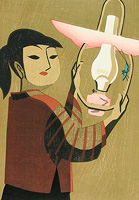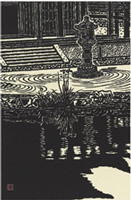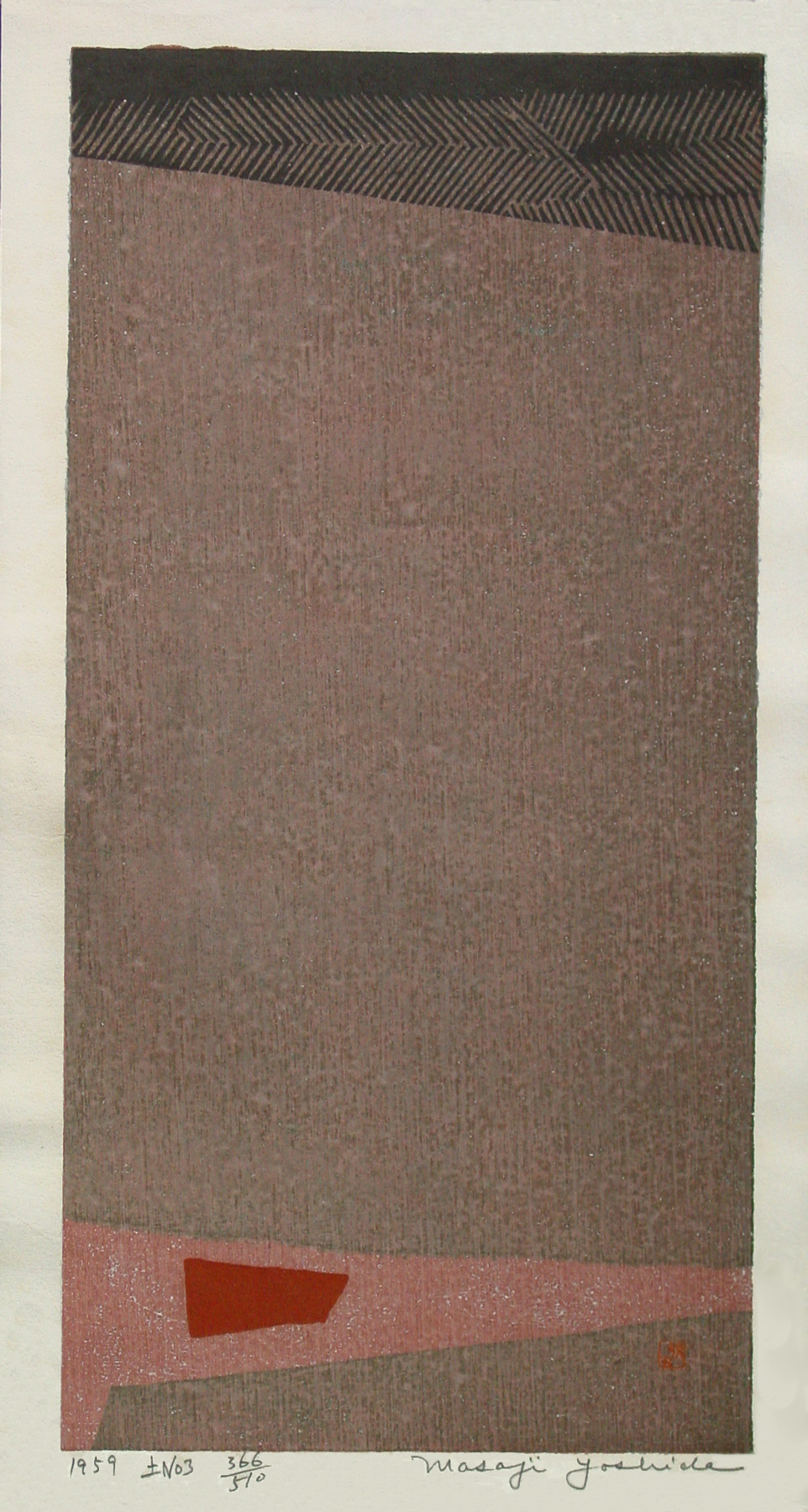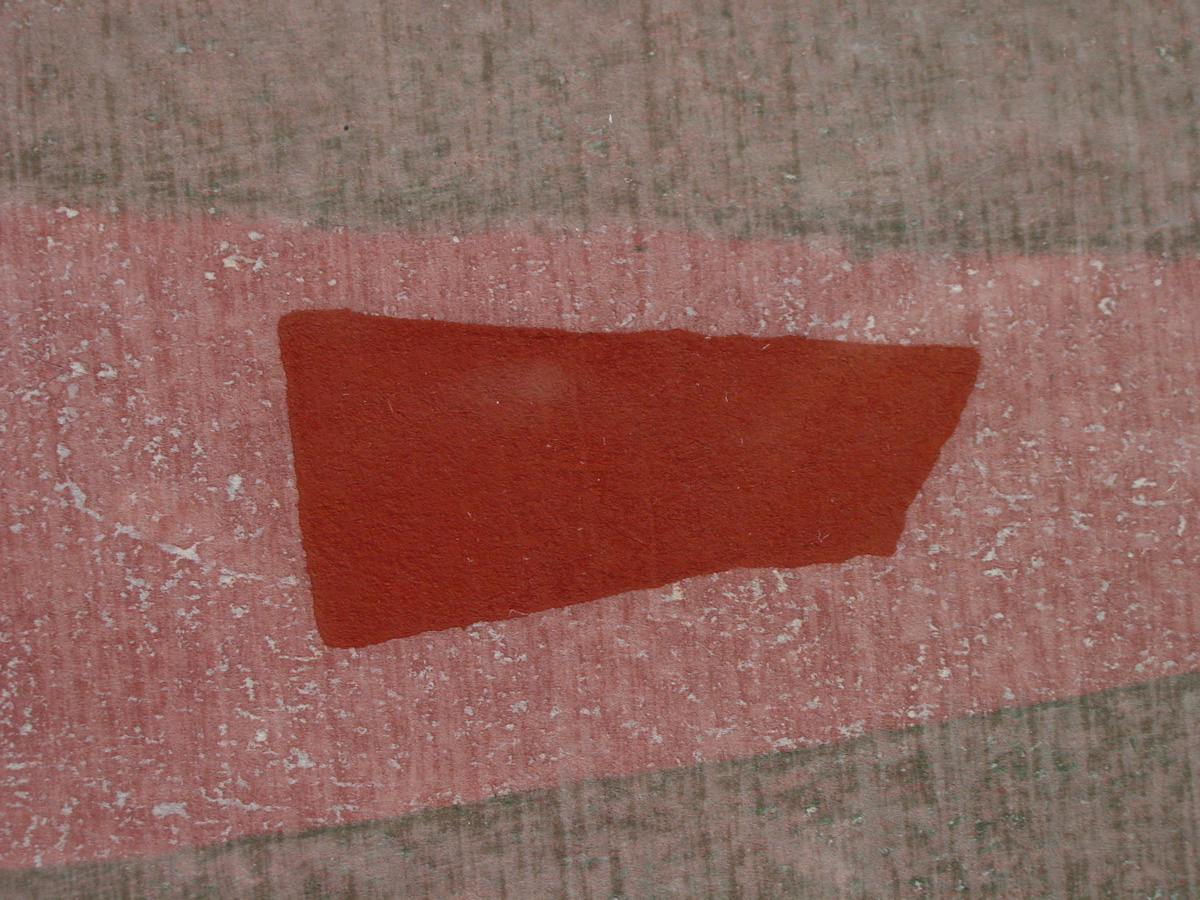About This Print
Source: The Modern Japanese Print - An Appreciation, James Michener, Charles E. Tuttle Co., 1968, p. 48-49.This print was one of ten chosen by committee to be included in James Michener's seminal 1962 work and portfolio of prints The Modern Japanese Print: An Appreciation. The comments of the artist on this work, along with Michener's comments, follow.
Comments of the Artist
This is one of my favorites among the prints I have made. In it I attempted to capture a new sense of the beauty of space and of the materials used. I tried to combine the sense of boundless expanse of earth, a quietly pulsating expanse of earth, with a new spatial composition. - Masaji Yoshida
Comments of James Michener
| Despite the artist's title for this print, it is so instinct with the essence of Japan and stands in such peculiar relationship to the artist and his emotional history that the Western observer feels impelled to find a more appropriate title; I myself think of it as "The World of Zen." Through a contemplation of this print one can attain, I think, a better sense of what the contemporary artists are after than in any other way. In the present print Masaji reaches far beyond any petty consideration of either representation or abst  Here is what I see in this rare print. On the spiritual level it is a subdued poem in praise of living a controlled and contemplative life, close to the earth. The equanimity of spirit that we seek, if we are wise, is extolled, and nature is presented to us in its subtlest mood, so as to harmonize with our own. It is an organized world, with its rocks and earth and mottled sky and restful colors well under control. It is a world of contemplation and solitude, one that Japanese intellectuals and mystics have constantly sought. It is, to be brief, a world of Zen. On the physical level this is no ordinary print. In some curious manner, surely intended by the artist, this work conjures up visions of the Ryoan-ji garden in Kyoto, that remarkable construction which uses rippling sand and protruding rock to represent the mystery of Japan’s islands rising from the sea. It is the most famous garden in Japan, a perfect evocation of an art form and one to which millions of visitors have paid homage. It is something very special, very Japanese: a small oblong of sand and rock and a little moss, but if one fails to comprehend it on first sight he can never hope to comprehend Japan. This print, with its dark rock at the bottom, its expanse of earth, its troubled sky, is surely an evocation of Ryoan-ji, the perfect representation of all that is finest in the Japanese reaction to nature.1  |
1 For a representational view of Ryoan-ji attributed to Masaji Yoshida see the print Stone Garden of Kyoto.
Technical Details
Artist’s title: Tsuchi 3 (Earth No. 3) or Ground No. 3. Four plywood blocks of basswood and lauan. Printed on hosho paper but, because of an unusually large number of unsatisfactory cast-offs, the paper was exhausted and a few prints (numbers 71, 75, 76, 90, 144, 146, 182, 194, and 262) were printed on torinoko. Seven colors (sumi ink, Japanese pigments, and transparent water colors), in various mixtures, applied in the following stages: entire area excepting pink strip and small brick-red block impressed twice with greenish color; entire area except brick-red block impressed twice very lightly with pinkish brown; black area and brick-red block impressed twice on each. The background texture, which varies from print to print, was obtained by applying the colors on very damp, unsized paper, producing a blotting-paper effect and causing the color to run and blur and blend more or less haphazardly. Thin sizing of doza1 applied to the finished print.1 a mixture of animal glues and alum to prevent blurring of the colorants
detail
Print Details
| IHL Catalog | #148 |
| Title | Tsuchi 3 (Earth No. 3 or Ground No. 3) |
| Series | Earth |
| Artist | Yoshida Masaji (1917–1971) |
| Signature | Artist’s signature in lower right margin |
| Seal | Artist’s red Masaji seal in lower right hand corner |
| Date | 1959 |
| Edition | 366/510 (475 of the edition were included in the original 1962 limited edition of The Modern Japanese Print – An Appreciation by James Michener) |
| Publisher | self-published |
| Impression | excellent |
| Colors | excellent |
| Condition | excellent - print is framed with archival (acid free) materials; minor foxing in the margins caused by the original presentation folder |
| Genre | sosaku-hanga (creative print) |
| Miscellaneous | |
| Format | |
| H x W Paper | 17 7/8 x 10 1/8 in. (45.4 x 25.7 cm) |
| H x W Image | 15 7/8 x 8 5/8 in. ( 40.3 x 21.9 cm) |
| Collections This Print | Los Angeles County Museum of Art M.78.122.47I edition 381/510, M.86.147.1i; Portland Art Museum (bound in the book The Modern Japanese Print by James Michener); Art Gallery of Greater Victoria (1965.172.009); Milwaukee Art Museum [bound in The Modern Japanese Print by James Michener (M2000.37)]; The British Museum 1981,0205,0.1.9; The Weatherspoon Art Museum 1981.2837.9; Honolulu Academy of Arts 14942 |
| Reference Literature | The Modern Japanese Print - An Appreciation, James Michener, Charles E. Tuttle Co., 1968, p. 48-50; The Legacy of Japanese Printmaking, Barry Till, Art Gallery of Greater Victoria, 1986, plate 91; Made in Japan - The PostwarCreative Print Movement, Alicia Volk, Milwaukee Art Museum, 2005; p. 77, pl. 47. |



